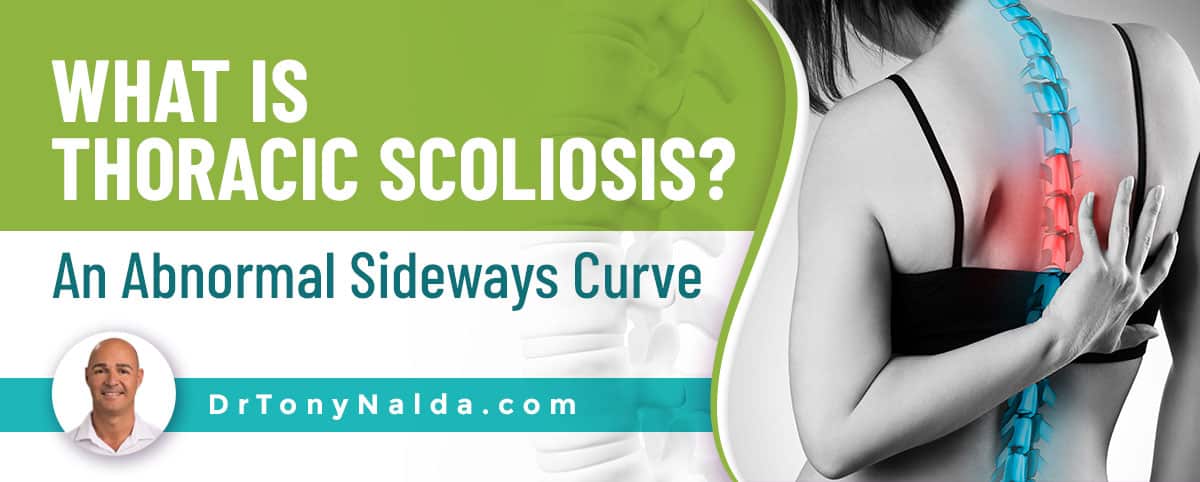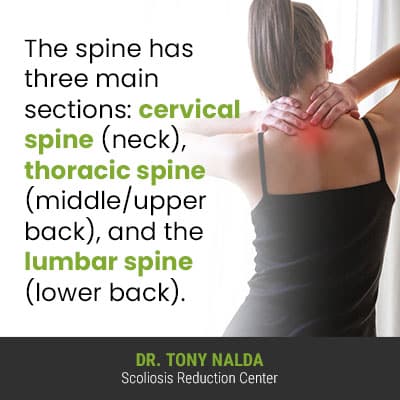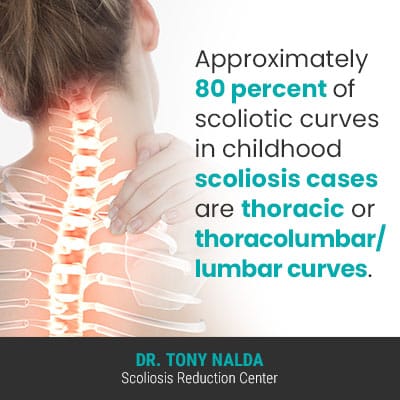What Is Thoracic Scoliosis? An Abnormal Sideways Curve

Not only does scoliosis range widely in severity, there are also different types a person can develop, in addition to affecting different spinal sections. Part of the diagnostic process involves further classifying conditions based on key patient/condition variables, curvature location being one of them.
Scoliosis can develop in any of the main spinal sections, and the thoracic spine, as the largest section, is the most commonly affected by scoliosis. Thoracic scoliosis means an unnatural sideways spinal curve, with rotation, has developed in the thoracic spinal section.
To start our discussion on thoracic scoliosis, let's start by exploring some basic spinal anatomy.
Table of Contents
Spinal Anatomy
In a healthy spine, the vertebrae (bones of the spine) are stacked neatly on top of one another, and this means the spine's healthy and natural curves are in place.
The spine's healthy curves make it better able to absorb and distribute mechanical stress incurred during activity, more flexible, and stronger, like a coiled spring.
In order for the spine to function optimally, it has to maintain its healthy curves and alignment; if the spine loses one or more of its healthy curves, its overall biomechanics are disrupted.
 The spine has three main sections: cervical spine (neck), thoracic spine (middle/upper back), and the lumbar spine (lower back).
The spine has three main sections: cervical spine (neck), thoracic spine (middle/upper back), and the lumbar spine (lower back).
Being Diagnosed with Scoliosis
Scoliosis is diagnosed by reaching a number of parameters.
Each spinal section has its own characteristic curvature type, and as scoliosis develops, this means an unnatural spinal curve, with rotation (twisting component) has developed.
In addition, when scoliosis is diagnosed, a scoliotic curve has to be of a minimum size: Cobb angle measurement of 10 degrees; this is confirmed via a physical exam that involves bending forward at the waist and X ray imaging so I can truly see what's happening in and around the spine.
Cobb angle is an important classification point as it indicates how far out of alignment a scoliotic spine is, while placing conditions on a severity scale:
- Mild scoliosis: Cobb angle measurement of between 10 and 25 degrees
- Moderate scoliosis: Cobb angle measurement of between 25 and 40 degrees
- Severe scoliosis: Cobb angle measurement of 40+ degrees
- Very-severe scoliosis: Cobb angle measurement of 80+ degrees
As a progressive condition, where a scoliosis is at the time of diagnosis is not indicative of where it will stay, and that's because scoliosis has it in its nature to worsen over time, particularly if left untreated, or not treated proactively.
In addition to severity, curvature location is another classification point that helps shape the design of effective treatment plans.
Curvature Location
Curvature location tells us where along the spine the scoliosis has developed, which helps determine where to concentrate our treatment efforts, in addition to symptoms of scoliosis patients can expect.
Symptoms of scoliosis will vary from person to person because scoliosis is such a highly-variable condition.
As mentioned earlier, scoliosis can affect the cervical spine, thoracic spine, and the lumbar spine, but it most commonly affects the thoracic spine, which makes sense as the middle/upper back is the largest spinal section.
While 33 vertebrae make up the spinal column, the thoracic spine is home to 12 of them (T1 - T12).
There is also what's known as a combined scoliosis, when a scoliotic curve involves more than one of the spinal sections.
Prevalence of Different Scoliotic Curve Types
Scoliotic curves that develop in the thoracic spine are the most common, accounting for 48 percent; the next most common curvature type is thoracolumbar curves, accounting for 40 percent.
Thoracolumbar scoliosis means the scoliotic curve includes both the lower thoracic spine and the upper lumbar spine as a combined scoliosis.
 Approximately 80 percent of scoliotic curves in childhood scoliosis cases are thoracic or thoracolumbar/lumbar curves.
Approximately 80 percent of scoliotic curves in childhood scoliosis cases are thoracic or thoracolumbar/lumbar curves.
When it comes to scoliosis patients and symptoms of scoliosis, patient age, condition type, and curvature location are all contributing factors.
Common Symptoms of Scoliosis
When it comes to pain as a scoliosis symptom, patient age is a crucial factor as scoliosis doesn't become compressive until patients have reached skeletal maturity.
Growing spines are undergoing a constant lengthening motion which counteracts the compressive force of the unnatural curvature of the spine, so once growth is done, the spine and its surrounding muscles and nerves are vulnerable to compression: the main source of condition-related pain.
So pain as a scoliosis symptom is more characteristic of adults with scoliosis for whom the condition has become compressive; in addition, adults also have natural age-related spinal degeneration to contend with, particularly when it comes to degenerative scoliosis symptoms.
In children and adolescents, common scoliosis symptoms include postural changes such as uneven shoulders, uneven shoulder blades, uneven hips, the development of an arch in the rib cage, and changes to gait, balance, and coordination.
In adults, pain is one of the most common symptoms of scoliosis.
How Does Curvature Location Affect Symptoms?
As mentioned earlier, classifying conditions in terms of curvature location is helpful not only because it tells us where to concentrate our treatment efforts, particularly with chiropractic care, but also because it can indicate likely symptoms.
When it comes to curvature location and symptoms, the area of the body closest to the affected spinal section is the most likely to feel the condition's direct effects.
For example, as the spine's surrounding muscles have to provide the spine with support, muscle spasms are an additional scoliosis symptom, so in thoracic scoliosis, muscle spasms are most likely to occur in the muscles located closest to the thoracic area.
If a patient's spine is curved unnaturally in the lower back, a common symptom/complication can be sciatica, and this is because the sciatic nerve starts in the lumbar spine.
In thoracic scoliosis, the development of a rib arch is generally more noticeable because the thoracic spine attaches to the rib cage, and as scoliotic curves increase in size, more and more uneven forces are exposed to the spine and its surroundings.
In addition, the degree of nerve damage/involvement is an important factor when it comes to symptoms.
If spinal nerves are compressed in the lower spine, its main effects will be felt by the lower body; if nerves in the thoracic spine are compressed, as the middle section, affects can be felt both in the upper and lower body, and cervical scoliosis is most likely to affect the nerves in the cervical spine, affecting the shoulders, neck, and head.
Once the condition is compressive, nerve pain is a significant issue, and remember, if a nerve root is compressed in the thoracic spine, for example, it can cause pain and discomfort felt anywhere along the compressed nerve's pathway, meaning pain can be felt far from its site of origin.
Radicular pain can feel like sharp shooting pains, electric shock-like pains, tingling sensations, numbness, and/or weakness, and is often felt in the body's extremities: arm and leg pain.
So now that we've defined thoracic scoliosis, while exploring some important patient/condition variables, let's move on to addressing treatment options.
Thoracic Scoliosis Treatment Options
As mentioned earlier, in addition to scoliosis ranging widely in severity, scoliosis also has different types, based on causation.
The most common form of scoliosis to affect both children and adults is called idiopathic scoliosis, and idiopathic means we don't fully understand what caused the condition's development.
In fact, 80 percent of known diagnosed cases of scoliosis are classified as idiopathic, while the remaining 20 percent are associated with known causes: neuromuscular scoliosis, degenerative scoliosis, and congenital scoliosis.
Cases of neuromuscular scoliosis are caused by the presence of a larger neuromuscular condition such as muscular dystrophy, cerebral palsy, or spina bifida.
The most common type of scoliosis overall is adolescent idiopathic scoliosis, diagnosed between the ages of 10 and 18, so this is the form we'll concentrate on when it comes to treatment options.
Treating scoliosis in children and adolescents means working tirelessly to counteract the condition's progressive nature, and this is because the main trigger for progression is growth and development, making children and adolescents who have not yet reached skeletal maturity vulnerable to rapid-phase progression.
In adult scoliosis, the focus of treatment is on reducing a curve back to where it was prior to becoming painful.
Treating a scoliotic spinal imbalance in the thoracic spine means working to restore as much of the spine's natural curves and alignment as possible.
Scoliosis Reduction Center Treatment
Here at the Scoliosis Reduction Center, patients benefit from a conservative chiropractic-centered treatment approach that believes in a proactive response to a scoliosis diagnosis by starting treatment immediately.
Remember, scoliosis is progressive, and for children and adolescents facing the constant trigger of growth and development, the goal is to significantly reduce the curvature and holding that reduction throughout growth.
By integrating multiple treatment disciplines, I can fully customize each and every treatment plan based on important patient/condition factors.
Through chiropractic care, I apply a series of chiropractic techniques and manual adjustments to work towards repositioning the curve's most-tilted vertebrae, at its apex, back into alignment with the rest of the spine.
Once I start to see those kinds of structural results (as a structural condition, scoliosis has to be impacted on a structural level), I use physical therapy and scoliosis-specific exercises to increase core strength so the spine is optimally supported by its surrounding muscles and postural remodeling.
A corrective scoliosis brace can be particularly effective on growing spines, so prescribing a ScoliBrace can help augment corrective treatment results by pushing the spine into a corrective position.
For the final phase of treatment, I prescribe a series of custom exercises to help patients establish a home-rehabilitation program so the spine can be further stabilized for long-term sustainable treatment results.
Conclusion
When it comes to thoracic scoliosis, we're talking about an abnormal sideways curvature of the spine in the thoracic area (middle/upper back).
As the largest spinal section, consisting of 12 vertebral bodies, it is the most common section to develop scoliosis and common symptoms include postural changes and pain (more common in adult scoliosis).
While there are never treatment guarantees, when scoliosis is treated proactively, the unnatural curvature of the spine can be reduced, progression can be prevented, and the need for invasive surgical treatment can be avoided.
When it comes to scoliosis surgery, we're talking about spinal fusion that comes with some heavy potential risks, side effects, and complications, but fortunately, the reality is that most patients can be treated with non operative treatment.
Conservative chiropractic-centered treatment offers patients a different potential outcome: one that's based on preserving as much of the spine's natural strength and function as possible.
Dr. Tony Nalda
DOCTOR OF CHIROPRACTIC
After receiving an undergraduate degree in psychology and his Doctorate of Chiropractic from Life University, Dr. Nalda settled in Celebration, Florida and proceeded to build one of Central Florida’s most successful chiropractic clinics.
His experience with patients suffering from scoliosis, and the confusion and frustration they faced, led him to seek a specialty in scoliosis care. In 2006 he completed his Intensive Care Certification from CLEAR Institute, a leading scoliosis educational and certification center.
About Dr. Tony Nalda
 Ready to explore scoliosis treatment? Contact Us Now
Ready to explore scoliosis treatment? Contact Us Now





